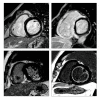Biomarkers in Acute Myocarditis and Chronic Inflammatory Cardiomyopathy: An Updated Review of the Literature
- PMID: 38068265
- PMCID: PMC10706911
- DOI: 10.3390/jcm12237214
Biomarkers in Acute Myocarditis and Chronic Inflammatory Cardiomyopathy: An Updated Review of the Literature
Abstract
Myocarditis is a disease caused by cardiac inflammation that can progress to dilated cardiomyopathy, heart failure, and eventually death. Several etiologies, including autoimmune, drug-induced, and infectious, lead to inflammation, which causes damage to the myocardium, followed by remodeling and fibrosis. Although there has been an increasing understanding of pathophysiology, early and accurate diagnosis, and effective treatment remain challenging due to the high heterogeneity. As a result, many patients have poor prognosis, with those surviving at risk of long-term sequelae. Current diagnostic methods, including imaging and endomyocardial biopsy, are, at times, expensive, invasive, and not always performed early enough to affect disease progression. Therefore, the identification of accurate, cost-effective, and prognostically informative biomarkers is critical for screening and treatment. The review then focuses on the biomarkers currently associated with these conditions, which have been extensively studied via blood tests and imaging techniques. The information within this review was retrieved through extensive literature research conducted on major publicly accessible databases and has been collated and revised by an international panel of experts. The biomarkers discussed in the article have shown great promise in clinical research studies and provide clinicians with essential tools for early diagnosis and improved outcomes.
Keywords: biomarkers; cardiac sarcoidosis; heart failure; imaging; inflammatory heart disease; myocarditis.
Conflict of interest statement
The authors declare no conflict of interest.
Figures





Similar articles
-
Biomarkers for Myocarditis and Inflammatory Cardiomyopathy.Curr Heart Fail Rep. 2022 Oct;19(5):346-355. doi: 10.1007/s11897-022-00569-8. Epub 2022 Aug 1. Curr Heart Fail Rep. 2022. PMID: 35913661 Free PMC article. Review.
-
What are the early warning signs of myocarditis during the pathway of care?Expert Rev Cardiovasc Ther. 2024 Oct;22(10):553-563. doi: 10.1080/14779072.2024.2416676. Epub 2024 Oct 24. Expert Rev Cardiovasc Ther. 2024. PMID: 39434698 Review.
-
[Indication for myocardial biopsy in myocarditis and dilated cardiomyopathy].Med Klin (Munich). 2005 Sep 15;100(9):553-61. doi: 10.1007/s00063-005-1076-3. Med Klin (Munich). 2005. PMID: 16170644 Review. German.
-
Viral Myocarditis-From Pathophysiology to Treatment.J Clin Med. 2021 Nov 11;10(22):5240. doi: 10.3390/jcm10225240. J Clin Med. 2021. PMID: 34830522 Free PMC article. Review.
-
Myocarditis in Paediatric Patients: Unveiling the Progression to Dilated Cardiomyopathy and Heart Failure.J Cardiovasc Dev Dis. 2016 Nov 8;3(4):31. doi: 10.3390/jcdd3040031. J Cardiovasc Dev Dis. 2016. PMID: 29367574 Free PMC article. Review.
Cited by
-
Characteristics and prognosis in acute myocarditis and unexplained acute chest pain: a nationwide longitudinal cohort study.Open Heart. 2025 Apr 4;12(1):e003050. doi: 10.1136/openhrt-2024-003050. Open Heart. 2025. PMID: 40185500 Free PMC article.
-
Tongxinluo capsule as a multi-functional traditional Chinese medicine in treating cardiovascular disease: A review of components, pharmacological mechanisms, and clinical applications.Heliyon. 2024 Jun 21;10(13):e33309. doi: 10.1016/j.heliyon.2024.e33309. eCollection 2024 Jul 15. Heliyon. 2024. PMID: 39040283 Free PMC article. Review.
-
A new online dynamic nomogram based on the inflammation burden index to predict cardiac injury after antitumor therapy in lung cancer patients.Cardiooncology. 2025 Mar 29;11(1):32. doi: 10.1186/s40959-025-00328-3. Cardiooncology. 2025. PMID: 40158125 Free PMC article.
-
C-reactive Protein (CRP) in Patients With Myocarditis: A Systematic Review and Meta-Analysis.Cureus. 2024 Oct 19;16(10):e71885. doi: 10.7759/cureus.71885. eCollection 2024 Oct. Cureus. 2024. PMID: 39564010 Free PMC article. Review.
-
Novel Therapeutic Approach Targeting CXCR3 to Treat Immunotherapy Myocarditis.Circ Res. 2025 Feb 28;136(5):473-490. doi: 10.1161/CIRCRESAHA.124.325652. Epub 2025 Feb 11. Circ Res. 2025. PMID: 39931812 Free PMC article.
References
-
- Ammirati E., Frigerio M., Adler E.D., Basso C., Birnie D.H., Brambatti M., Friedrich M.G., Klingel K., Lehtonen J., Moslehi J.J., et al. Management of Acute Myocarditis and Chronic Inflammatory Cardiomyopathy: An Expert Consensus Document. Circ. Heart Fail. 2020;13:e007405. doi: 10.1161/CIRCHEARTFAILURE.120.007405. - DOI - PMC - PubMed
-
- Caforio A.L., Pankuweit S., Arbustini E., Basso C., Gimeno-Blanes J., Felix S.B., Fu M., Helio T., Heymans S., Jahns R., et al. Current state of knowledge on aetiology, diagnosis, management, and therapy of myocarditis: A position statement of the European Society of Cardiology Working Group on Myocardial and Pericardial Diseases. Eur. Heart J. 2013;34:2636–2648. doi: 10.1093/eurheartj/eht210. - DOI - PubMed
-
- Tschope C., Ammirati E., Bozkurt B., Caforio A.L.P., Cooper L.T., Felix S.B., Hare J.M., Heidecker B., Heymans S., Hubner N., et al. Myocarditis and inflammatory cardiomyopathy: Current evidence and future directions. Nat. Rev. Cardiol. 2021;18:169–193. doi: 10.1038/s41569-020-00435-x. - DOI - PMC - PubMed
Publication types
Grants and funding
LinkOut - more resources
Full Text Sources
Research Materials

